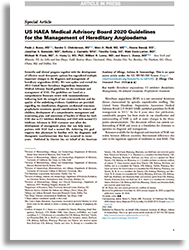With eight products currently approved by the FDA for preventing and treating Hereditary Angioedema (HAE) attacks, and several therapies approved for generic use, people with HAE and their physicians have options for developing an HAE treatment plan tailored to meet each person's unique needs.
Before there were approved treatments for HAE, anabolic steroids (also known as androgens) such as danazol, oxandrolone, and stanozolol were the most commonly prescribed preventive HAE therapies. While anabolic steroids have been shown to be useful, they are not well-tolerated by many women, directly linked to liver toxicity, and can cause an increase in cholesterol levels. In addition, these drugs should not be used to treat children. Research indicates that patients treated with anabolic steroids can experience breakthrough laryngeal or abdominal attacks that require hospitalization.

The treatment of HAE has undergone dramatic changes as newer medicines have become available in recent years. Optimal care of HAE patients requires a comprehensive management plan. The US HAEA Medical Advisory Board has developed evidence-based recommendations for the diagnosis and treatment of HAE. If your doctor is unsure how to treat you or your loved one, please contact an HAE Advocate at 866-798-5598, who can help you get in touch with an HAE expert physician in your area.


According to recent studies, pregnancy may aggravate or alleviate symptoms in equal proportion. It is important to create an individualized HAE treatment plan during pregnancy.
VISIT OUR PREGNANCY PAGE